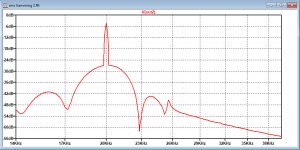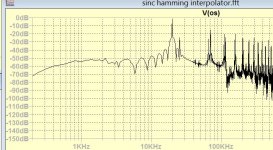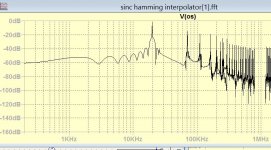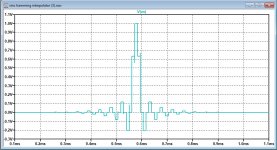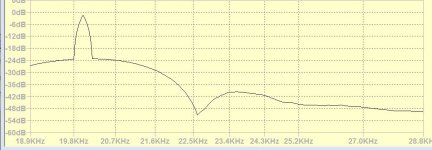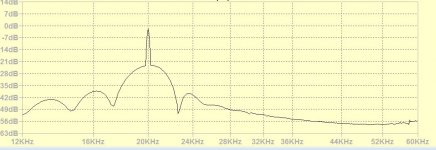I'm so sorry again, I didn't take the time to check.
the VCVS E31 in the version I sent you has a gain of 1.15.
This should be -1.
Here is the tested version with an impulse response.
Look at Out2 and you should see a nice response as in #334.
Hans
.
the VCVS E31 in the version I sent you has a gain of 1.15.
This should be -1.
Here is the tested version with an impulse response.
Look at Out2 and you should see a nice response as in #334.
Hans
.
Attachments
I don't understand why you delay the original samples by 15.5 samples and why the clock ck is reversed by delaying 11us. All I see from the FFT the OS to be this.
View attachment 924917
Are you sure mine was wrong? I make the OS to be first the 16th on the positive, as the sampler acts on the rise, and switch to the midpoint on the negative.
It’s working properly, isn’t it?
That’s all that counts.
I could have taken a sample from your delay line, but this was more flexible, and for the anogue delay I needed a separate delay line anyhow.
It’s beautiful weather here, like spring.
And I preferred to sit in the sun instead of behind a PC.
That’s why I didn’t take the time to check things as I normally try to do.
But the last .asc file is right.
Hans
OT Warning:
Some people say Chord DAVE sounds more like real music than the $100,000 complete dCs Vivaldi setup. One guy who said that owns both of them. In addition, Chord has a 'prescaler' for use with DAVE and Hugo TT 2 that adds a million tap preprocessing filter before the dac. People say both dacs sound better with the prescaler. Don't know about Stereophile in every case, but have it on good account that sometimes they can't say what they know or they will lose advertising revenue they need to survive. Only the German hifi magazines are willing to tell it like it is.
Anyway, longer filters do seem to be preferred by many.
Hi Mark,
Nice friends that you have.
Do you happen to remember which German magazine it was that tested the Chords?
Hans
Hi Hans,
There is some commentary about the German magazines in the 'ES9038Q2M Board' thread, perhaps see #4248 and #4250.
ES9038Q2M Board
ES9038Q2M Board
Regarding the guy I mentioned who owns both hi-end dacs, a bit more if PM.
Mark
There is some commentary about the German magazines in the 'ES9038Q2M Board' thread, perhaps see #4248 and #4250.
ES9038Q2M Board
ES9038Q2M Board
Regarding the guy I mentioned who owns both hi-end dacs, a bit more if PM.
Mark
Hayk,
I saw that you did not download the Sinc Hamming 2.asc file from #341 ready to run the Impulse Response.
The impulse response is the ultimate test to check the correct working of the model.
Or did you alter E31’s gain from 1.15 to -1, and do you now get the correct FR with 20K input as in #342 ?
Hans
I saw that you did not download the Sinc Hamming 2.asc file from #341 ready to run the Impulse Response.
The impulse response is the ultimate test to check the correct working of the model.
Or did you alter E31’s gain from 1.15 to -1, and do you now get the correct FR with 20K input as in #342 ?
Hans
Attachments
Last edited:
You have to sample the signal to feed it into the DFT; was something getting sampled exactly during a transition?
I am looking about DSP.
how about these.
STM32F407VET6 development board Cortex M4 STM32 minimum system learning board ARM core board|Integrated Circuits| - AliExpress
ADAU1401/ADAU1701 DSPmini Learning Board Update To ADAU1401 Single Chip Audio System 4XFB|Water Filter Parts| - AliExpress
Free shipping DSP board DSP2812 TMS320F2812PGFA|ABS Sensor| - AliExpress
how about these.
STM32F407VET6 development board Cortex M4 STM32 minimum system learning board ARM core board|Integrated Circuits| - AliExpress
ADAU1401/ADAU1701 DSPmini Learning Board Update To ADAU1401 Single Chip Audio System 4XFB|Water Filter Parts| - AliExpress
Free shipping DSP board DSP2812 TMS320F2812PGFA|ABS Sensor| - AliExpress
The only thing I needed to change to be similar to yours is the rise and fall of the clock ck. With 0 rise, fall.
View attachment 925141
With 0.05u rise fall.
View attachment 925142
How strange?
With -40db image, my interpolator is a excellent.
You are close but still not perfect.
Look at the image in #342 at 0dB with the first mirror at -37dB.
Yours is at -25dB for a 0dB signal.
Try to sim an impulse response, that’s the easiest way to find out if everything is O.K. Image should be flawless like in posting #334
Hans
I'll see after applying the cubic spline interpolator, along with the delta sigma .
What DSP do you use?
What DSP do you use?
Last edited:
This DSP board less than 10$ including shipment has the following feature.
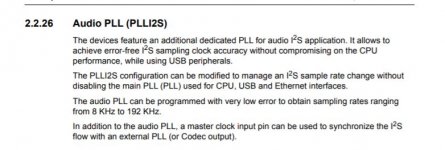
It doesn't have PCM output as the 750, I suppose I can program the GPIO pins to supply my five DACs.
STM32F407VET6 STM32F407VGT6 Development Board F407 MCU Learning Board STM32 System Board|Integrated Circuits| - AliExpress

It doesn't have PCM output as the 750, I suppose I can program the GPIO pins to supply my five DACs.
STM32F407VET6 STM32F407VGT6 Development Board F407 MCU Learning Board STM32 System Board|Integrated Circuits| - AliExpress
Attachments
Last edited:
Increasing the gain of the interpolated values by 3%, the image simply vanishes.
View attachment 925524
I must multiply all my coefficients by 1.03.
Why don’t you simply multiply 3% after having added all samples.
It almost seems as if you have calculated the filter coefficient whith a small 3% error ?
adjusted to 44.1khz it needs 8.3% extra gain. To say that the clock has half the period on but 0.05us rise and fall. If I subtract the rise from the on time to have it 50% duty cycle, I get lot of parasite pulses.
View attachment 925538
That’s why you should better use the sample input instead of the clock input of the S&H.
That relieves you from calculating 50% dutu cycle.
Hand
- Home
- Source & Line
- Digital Line Level
- Analog Delta-Sigma interpolation DAC
